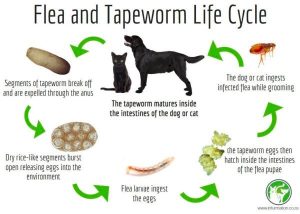144 Do The Worm!
Intestinal Parasites in Dogs and Cats
Julia Swoish, Destiny Smith, Maura McManus
Student Learning Objectives
-
Students will be able to identify and describe the life cycles, transmission routes, and anatomical locations of common intestinal parasites in dogs and cats
-
Students will be able to analyze the clinical signs and health impacts associated with each parasite and explain how these symptoms relate to the parasite’s location and feeding behavior within the gastrointestinal tract.
-
Students will be able evaluate and compare diagnostic, treatment, and prevention strategies
 Intestinal Parasites
Intestinal Parasites
There are many different types of parasites that can infect our animals. Intestinal parasites are organisms that live within the gastrointestinal (GI) system of a host organism. Parasites can steal the nutrients in our animals’ bodies and cause weight loss if they go undetected for too long. The small intestine is the primary site for nutrient and fluid absorption, and many parasites steal these nutrients for themselves. Other symptoms of intestinal parasites include vomiting, diarrhea, inability to gain weight, and in some cases lethargy and blood loss.
Whipworms
Whipworms reside in the cecum which is a pouch-like structure where the small and large intestine meet.

Dogs become infected with whipworm by swallowing eggs in the soil or feces of other dogs. Dogs can be infected by licking their paws after going outside or licking human shoes that have stepped in feces. Cats can get whipworm, though it is less common. Many dogs are on a monthly preventative medication that prevents infection of these types of worms.
When dogs have whipworm, they will have weight loss, bloody diarrhea, lethargy, and weakness.

Treatment for whipworm includes deworming medication and supportive therapy for any excessive symptoms like dehydration.
Tapeworms
Tapeworms are common in dogs and cats that go outside. This is because they are transmitted by ingesting fleas. They can also be transmitted by ingesting other wildlife carcasses with a flea infestation. Tapeworm can also be transmitted to humans so it is important to protect against tapeworm! Weight loss is possible if the animal is severely affected, and small rice-like particles can be found around the anal area and in the feces. Animals can also scoot, as their anus may be irritated. Scooting is also a common symptom of anal gland issues, so always contact a veterinarian if there is concern. Tapeworm infection is more serious in young animals, causing issues with growth, decreased healthy red blood cells, and intestinal blockages. Animals with tapeworm can be treated with a de-wormer to kill the tapeworm, but the best way to prevent tapeworm is to keep dogs and cats on a monthly flea and tick preventative. It is also important to prevent animals from eating wildlife. Tapeworms are especially common in the midwest and great lakes area.


Roundworms
Similar to whipworms, roundworms are transmitted via ingestion or sniffing of infected feces. Eggs can be spread by other animals such as rodents, birds, and earthworms.

Roundworms live in the intestines and feed off of partially digested food. In other words, our animals start digesting the food, and the roundworms will take the nutrients from the food. This robs the animal of the nutrients they need to grow and function, causing stunted growth in puppies and kittens. Animals with roundworms also may have a pot-bellied appearance in addition to continual diarrhea. Roundworms look like spaghetti when they come out in the animal’s feces.
Treatment for roundworm includes a deworming treatment repeated in several two week intervals to ensure that the adults and eggs are dead. Monthly preventatives should also take care of roundworms.
Hookworms
 Hookworms are similar to the other types of intestinal parasites in the sense that they are ingested orally. They are one of the more dangerous types of worms as they can cause severe damage to the intestinal tract if left untreated. Hookworm reside in the small intestine but can also migrate to the lungs, resulting in respiratory distress. Hookworms thrive in humid, warm climates, therefore the southeastern US is more affected by hookworm infection. Hookworm is treated with dewormer, and most monthly preventative contain prevention for hookworm infection.
Hookworms are similar to the other types of intestinal parasites in the sense that they are ingested orally. They are one of the more dangerous types of worms as they can cause severe damage to the intestinal tract if left untreated. Hookworm reside in the small intestine but can also migrate to the lungs, resulting in respiratory distress. Hookworms thrive in humid, warm climates, therefore the southeastern US is more affected by hookworm infection. Hookworm is treated with dewormer, and most monthly preventative contain prevention for hookworm infection.
Giardia

Giardia is the most common intestinal parasite in dogs. It is ingested orally, and is notorious for reinfection. Symptoms of giardia include diarrhea, weight loss, dehydration, and sometimes vomiting. Locations with high traffic of dogs are particularly at risk for carrying giardia. These would be locations such as dog parks, day care, and puppy training classes.

Giardia is treated with a dewormer, but may need supportive therapies if the diarrhea was particularly dehydrating. Dogs should also be bathed on the first and last day of treatment to prevent reinfection.
Most deworming medication is broad spectrum and wide acting meaning that they will cover many different types of parasites with one medication. If you are ever concerned about parasite infestation in your animals, please contact your veterinarian.
See below for a recap video of the worms discussed in this chapter. There is also an info-graphic from puppypoop.com which has helpful information regarding the different worms and what we can do to prevent and treat these types of infections.

With your newfound knowledge, try your hand at diagnosing some cases.

